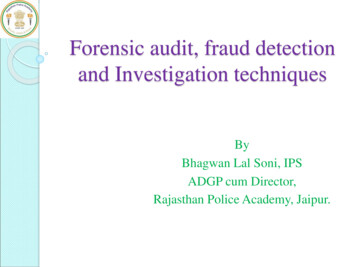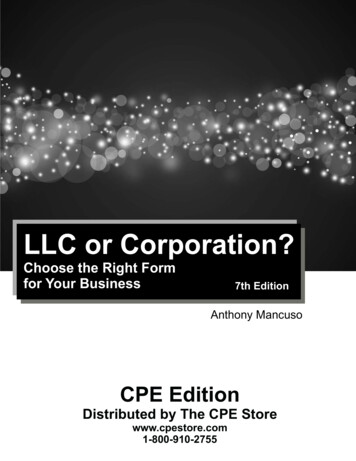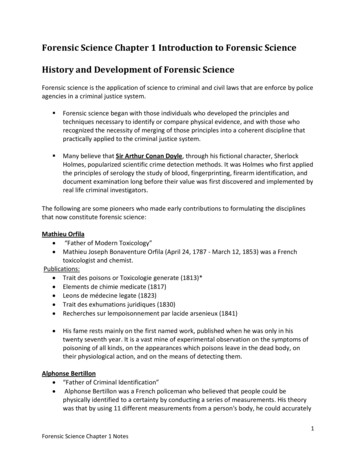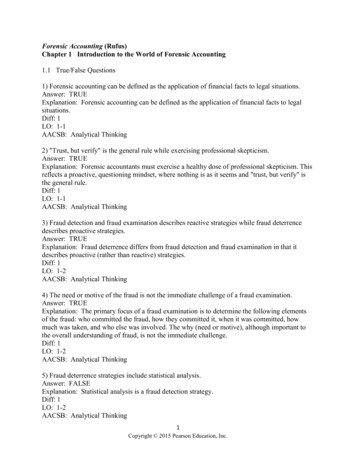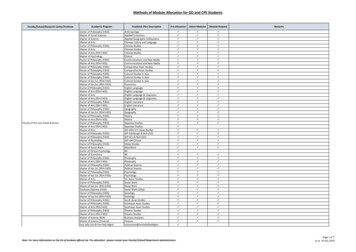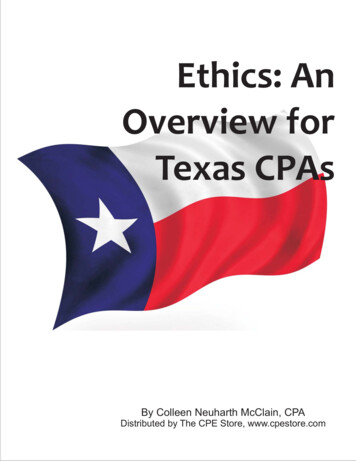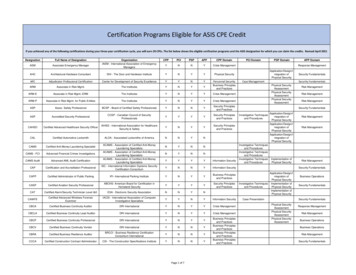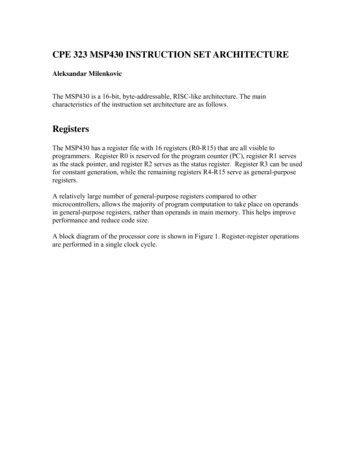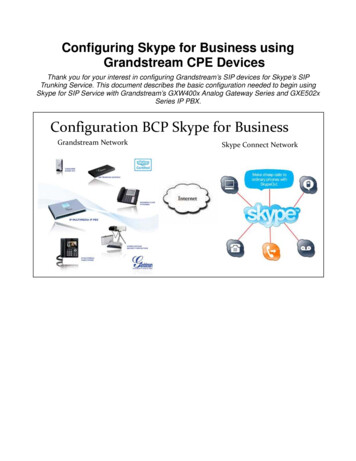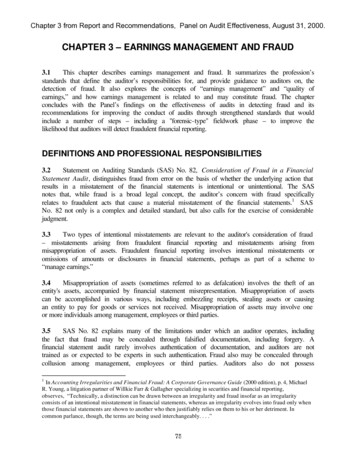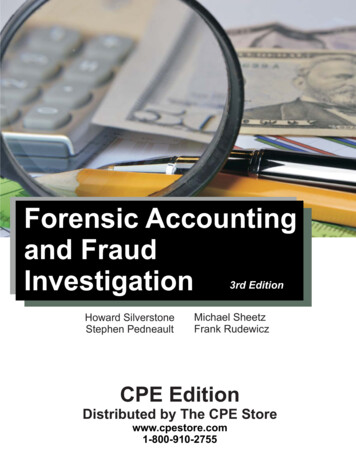
Transcription
Forensic Accountingand FraudInvestigation3rd EditionHoward SilverstoneStephen PedneaultMichael SheetzFrank RudewiczCPE EditionDistributed by The CPE Storewww.cpestore.com1-800-910-2755
Forensic Accounting andFraud InvestigationCPE EditionStephen PedneaultFrank RudewiczMichael SheetzHoward Silverstone
Copyright 2012 by John Wiley & Sons, Inc. All rights reserved.No part of this publication may be reproduced, stored in a retrieval system, or transmitted in any form or by anymeans, electronic, mechanical, photocopying, recording, scanning, or otherwise, except as permitted under Section107 or 108 of the 1976 United States Copyright Act, without the prior written permission of the Publisher.CPE Edition published by The CPE Store, Inc., www.cpestore.com, 1-800-910-2755. Reprinted with permissionfrom John Wiley & Sons, Inc. The Course Information, Learning Objectives, Review Questions and ReviewAnswers are the sole property of The CPE Store and do not appear in the original edition of the text published byJohn Wiley & Sons, Inc. Above-mentioned items are Copyright 2012 by The CPE Store, Inc. All rights reserved.Limit of Liability/Disclaimer of Warranty: While the publisher and author have used their best efforts in preparingthis book, they make no representations or warranties with respect to the accuracy or completeness of the contents ofthis book and specifically disclaim any implied warranties of merchantability or fitness for a particular purpose. Nowarranty may be created or extended by sales representatives or written sales materials. The advice and strategiescontained herein may not be suitable for your situation. You should consult with a professional where appropriate.Neither the publisher nor author shall be liable for any loss of profit or any other commercial damages, including butnot limited to special, incidental, consequential, or other damages.Printed in the United States of America
Course InformationCourse Title: Forensic Accounting and Fraud InvestigationLearning Objectives: Recognize the definition of forensic accounting Pinpoint the term that became commonplace after financial statement fraud schemes occurred inthe early part of this century Identify what bankruptcy fraud is Determine what damages are a key component of Recognize the definition of occupational fraud Determine the number of accounting cycles which are common within any business Recognize what white collar fraud involves Pinpoint the accounting cycle where kickbacks to customers may take place Ascertain when the Sarbanes-Oxley Act was passed Determine when a forensic investigation may be undertaken Identify the two primary bases of accounting Discern which financial statement conveys the financial position of a business at one point intime Identify the three main types of entities Discern which type of entity is most easily started and administered Recognize the term which refers to entities whose legal authority allows them to exist in a hostcountry Pinpoint the factor which is key to a financial crime scheme Recognize the three main measures of financial analysis Ascertain the standard measure of an entity’s financial health Recognize what makes a good financial investigator Discern how responsibilities are defined within a company Pinpoint the most common targets of fraud Recognize how businesses can be victims of fraud Pinpoint the account that all accounting cycles pass through Identify one of the fastest growing crimes Recognize what the Tammany Society was Identify the criminal organization that is responsible for nearly 500 million per year in crime Recognize the process by which criminal enterprises convert dirty money into legitimateappearing income Identify the three stages of money laundering Recognize the two general categories for investigation of financial crimes Identify the basis for most fraud investigations Pinpoint the characteristics that help predict how successful an investigation will be Identify the two types of solvability factors Recognize the parts of an investigative plan Determine what term is used for a conversation with a purpose Identify how interviews are traditionally categorized Recognize one of the most promising advances in the interview area Discern the two categories of evidence Recognize the term which means that all evidence submitted to prove a claim must be the original Identify the key to any document organization system
Pinpoint the item which is built in chains and must lead logically from point A to point BRecognize the type of evidence that proves or disproves an issue in contentionDetermine what a two-dimensional representation of a three-dimensional relationship amongobjects is known asIdentify the basic symbols of a link diagramRecognize what edges in a diagram representIdentify the concept which is used to assess the overall strength of a networkRecognize a type of graphic representations of an inferential relationshipsIdentify the term which is used to differentiate between heterogeneous and homogenous evidencePinpoint the term used for evidence that indirectly proves the facts in questionDiscern which term is used for the list or database that contains a numerically indexed list ofpropositions and evidenceRecognize what a casebook isIdentify the different sections of a casebookPinpoint the two schools of thought regarding report writingRecognize what the lawyer’s ultimate job is, from a litigation perspectiveDiscern the position from which a professional witness testifiesIdentify the two roles that financial experts play in the litigation processSubject Area: AccountingPrerequisites: NoneProgram Level: OverviewProgram Content: Forensic Accounting and Fraud Investigation provides an up-to-date resource fordetecting, preventing, and successfully prosecuting financial fraud. It addresses all phases of forensicaccounting, complete with actual examples demonstrating application in the real world. It provides nonexperts with access to all the critical accounting principles and investigative techniques that help protectany organization from fraud, including insightful advice on where an organization is most susceptible tofraud and how to implement effective investigation processes when fraud is suspected.Advance Preparation: NoneRecommended CPE Credit: 20 hours
Table of ContentsPreface . vChapter 1 – Forensic Accounting . 1Learning Objectives . 1What Is Forensic Accounting. 1Why Has Forensic Accounting Become the Buzz? . 2Introduction to a Profession . 3Applications for Forensic Accounting. 3A Third Dimension: Contexts within Each Area of Specialization . 6Conclusion. 8Suggested Readings . 9Review Questions . 10Review Answers . 11Chapter 2 – Fraud in Society. 12Learning Objectives . 12What Is Fraud? . 12Types of Fraud . 15Other Types of Financial Fraud . 17Sarbanes-Oxley . 18What the Numbers Tell Us about Fraud . 19Categories of Occupational Fraud . 20Drawing Conclusions . 21Society’s Perception of Fraud . 22Who Commits Fraud?—Profile of the Typical Fraudster . 23The Social Consequences of Economic Crime . 27Conclusion. 27Suggested Readings . 27Review Questions . 28Review Answers . 30Chapter 3 – Understanding the Basics of Financial Accounting. 32Learning Objectives . 32Where It All Begins . 32The Five Accounting Cycles. 34Journals: Subsidiary and General . 39Conclusion. 40Suggested Readings . 40Review Questions . 41Review Answers . 42Chapter 4 – Forms of Entities . 44Learning Objectives . 44Basics of Business Structures . 44Sole Proprietorships . 44Partnerships . 45Corporations . 47Business Enterprises in the Global Environment . 48Conclusion. 51Suggested Readings . 51Review Questions . 53Review Answers . 54
Table of ContentsChapter 5 – Fundamental Principles of Financial Analysis . 55Learning Objectives . 55Good Analysis Due Diligence? . 55Why Perform Financial Analysis? . 57What and Whom Can You Trust?. 57Other Factors to Consider .
Forensic Accounting and Fraud Investigation for Non-Experts, Third Edition, was written with the non-accountant in mind, aimed to demystify what often is character-ized as complicated. The reality is most fraud and financial crime that occurs is not over-ly complicated, just made to appear that way either for concealment purposes or as a means of defense for the suspect or suspects when it .
